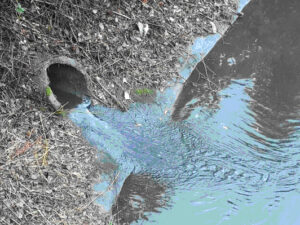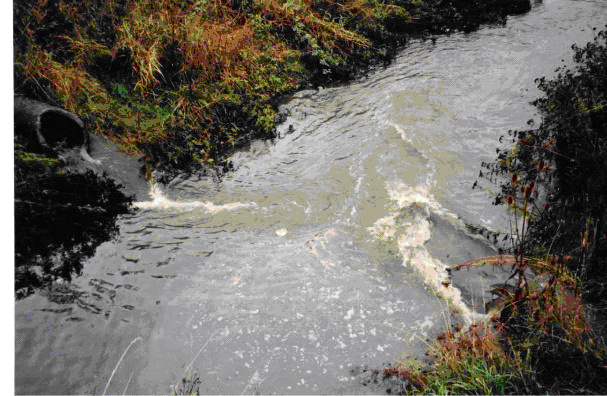Since 1970, the C-Street storm drain flowed directly into Clover Creek. Now 50 years later, despite an increase in traffic and population the storm drain is still in the planning stage with no completion date in site. Can this be changed?____________________________________________________________
Priority for County’s Polluted Water in Street Drains Must Change
by Kirk Kirkland
“For more than 50 years, polluted storm water from streets has been collected and piped directly into Clover Creek. Unfortunately, low impact development, requiring on-site infiltration of runoff, was not in effect during most of this time,” said Al Schmauder, a long-time advocate for clean water. “In the 1960s, Clover Creek was a salmon stream, but it has deteriorated with the increase of suburban development.”
In August, Schmauder asked the Economic Infrastructure and Development Committee of the Pierce County Council to prioritize the replacement of storm drains in this populated watershed. “In recent years, we learned that a toxic chemical from tires is deadly to Coho salmon and that it is present in runoff from streets and parking lots.”
Polluted runoff from drains to creeks and lakes is not only bad for fish, but it also seeps into the ground to replenish the water in the aquifer that is used for drinking, bathing, and cooking. “Thus, it is critical to ensure road runoff is cleaned and filtered before it is allowed to get into the drinking water supply,” said Schmauder.

C-Street Storm Drain in 1992
Historically, Pierce County has not prioritized the installation of stormwater filters that would remove pollutants from runoff in the Clover Creek Watershed. For example, two 18-inch drains at “C” Street have drained road runoff directly into Clover Creek since 1970 (see above).
“The C-Street North drain retrofit project represents an over $2 million project to improve the water quality in the most urban and intensive area in the watershed along the Pacific Avenue Corridor,” according to Tim Hagan from Surface Water Management.
After 54 years, one of these drains is finally scheduled to be ‘retrofitted’ and fixed, but there is no long-range plan to address other storm drains in the watershed. The funding in this year’s budget is only designated for the design stage of one drain in the next 6-year Pierce County Surface Water Plan.
In the last three years at each county budget discussion, Schmauder and others have met with County Councilmembers and asked for a plan to deal with all the critical storm drains in the watershed that need filters installed. Such a plan should have fixed one or two storm drains each year using the funding that comes from taxes collected in the Spanaway/Parkland/Midland area. At this year’s budget hearing, there was still no long-range plan in place. Instead, there was only a notice that the other C-Street North drain is the next project in line, but there was no set completion date.
Since 1970, the Pacific Avenue Corridor and surrounding neighborhoods where Clover Creek flows have experienced substantial suburban sprawl. After the county’s Growth Management Plan was created in the 1990s, county planners designated significant housing growth increases in the Parkland and Spanaway Community Plan.
This year, the 2022-2027 Capital Facilities Plan allocates about $50 million for 49 projects. The allocation is a political decision, as the priority that creates the Storm Improvement Plan comes from the County Executive’s office, not the County Council.
The Executive’s office has favored rural drains over urban drains.
It is estimated that over $22 million is collected annually from residents in all of the county’s watersheds. This amounts to an average fee of $140 for single family residents. Another estimate suggests that 50% of these fees are paid by citizens living in the Clover Creek Watershed, or about $11 million each year.
Since 1988, the Storm Water Management (SWM) staff prioritizes potential projects based on flood risk reduction, water quality, and habitat, but the main factor is the County Executive’s Strategic Objectives. Getting a long-range plan to filter drains in the urban growth area has been difficult under the current Executive.
What do Watershed Residents Receive for Their Money?
In the current 2022-2027 Capital Facilities Plan, the Pierce County Council votes for about $50 million for these 49 projects. Of these, only two water quality projects are designated for the Clover Creek Watershed, both of which are in the planning stage.
During this next 6-year plan period, residents in the Clover Creek Watershed will pay about $66 million in stormwater fees but will only receive two projects, costing about $2.6 million. That is merely a 4% return on residents’ storm water service charges.
Collecting water quality data and updating maps of this watershed by the staff is certainly part of what is needed. Planning by itself will not solve the problem. To change the budget to prioritize drain replacement projects in the urban growth area, there needs to be a change in County Executive.
Coordination of priorities is possible only by electing a better County Executive this November. It’s the only way Spanaway/Parkland/Midland will receive a fair return on their investment of $11 million tax dollars from SWM.


